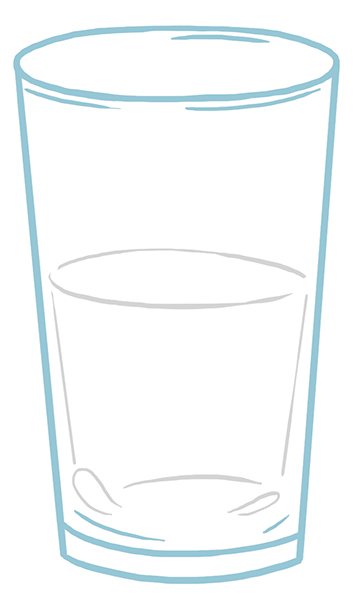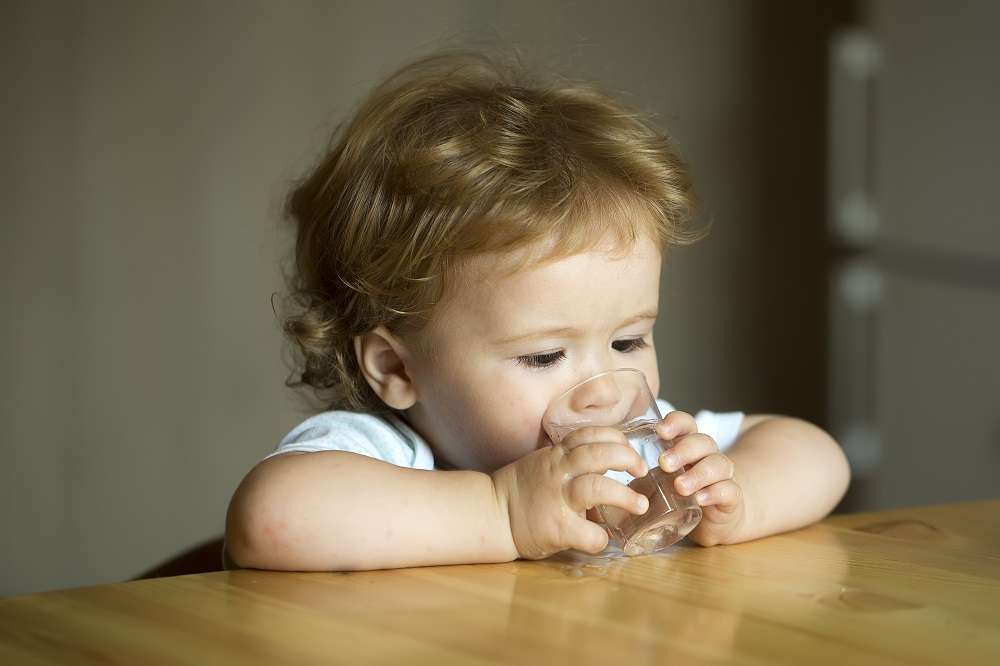Your body uses lots of water every day for its different processes. The same is true for children! Since they don’t necessarily recognize the signs of thirst, you need to make sure they stay hydrated.
How much do they need to drink?
Young children need to drink a lot of liquid. They should be drinking between 2½ and 5 cups (between 600 and 1,200 ml) each day, which is around 5 to 10 small glasses. Since they can forget to drink when they’re busy playing, it’s important to invite them to drink often, even if it’s a very small amount.
Children may need to drink even more when:
- it’s very hot out;
- they’re being active;
- they’re sick (since they may have a fever, be vomiting or have diarrhea).
It’s very important to make sure your child doesn’t get dehydrated.
Did you know? All liquids count, even in foods: soup, the water in fruits and vegetables, juice, etc.
But the best way to keep your little one hydrated is to have them drink water!

Dehydration
Here are a few signs that your child may be dehydrated:
- Dry mouth and lips
- Lack of tears, dark circles under the eyes, sunken eyes
- Increased thirst
- Less urine than usual or no urine for 6 to 8 hours
- Drowsy or irritable
- Very rapid or very slow heartbeat
- Fever
If your child has these symptoms, it’s important that they be seen by a doctor.
Should I give water to my infant?
If your baby is solely breastfed or bottle-fed, you don’t need to also give water. The milk will meet their needs. When it’s very hot out, encourage them to feed more often. You can start giving your baby water at around 6 months old, when they start eating solid foods.
What should I give to drink?
Water above all!
We can never say it enough: nothing quenches thirst like water! You don’t need to give your baby bottled water. Water from the tap or a water fountain, which meets quality standards, is fine.
Avoid giving mineral (sparkling) water because it can contain a lot of salt. Also avoid giving hot water from the tap since it may contain more contaminants and bacteria than cold water.
Milk and fortified plant-based drinks
Milk is a good option for your little one’s meals and snacks. In fact, milk is the most nutritious drink. It provides calcium and vitamin D, which help build strong teeth and bones. And the protein in milk is important for growth.
- Up to 2 years old, give milk that has a 3.25% milk fat (M.F.) content.
- When your child turns 2, you can also give them fortified soy beverages. Don’t forget to shake well before serving since the calcium may have settled at the bottom of the carton!
Almond milk, rice milk, oat milk and other such beverages are not recommended for very young children. They contain much less protein and sometimes less fat than milk and soy drinks. Because of this, they don’t meet the needs of children under 2. However, they can be offered on occasion after age 2.
Sweet beverages: not necessary!
Children don’t need fruity, sugary drinks. Besides not satisfying hunger, they can make little ones more interested in sweet foods and drinks. Also, these beverage are often consumed instead of water or milk. And they contain sugar, which can cause cavities.
What about 100% pure fruit juices? It’s true that these are less processed and often contain more vitamins than fruit-flavoured drinks and fruit punches. However, they don’t contain the fiber found in whole fruit, which satisfies hunger and regulates sugar absorption. This is why it’s better to give your child whole fruit rather than fruit juice.
Pure fruit juice can have its place in a balanced diet, but in reasonable quantities. According to Canada’s Food Guide, one serving of fruit juice is ½ cup (125 ml). Given that even a small cup or glass will contain more, keep a close eye on how much you serve.
Some juice tips:
- To respect the Food Guide’s recommendations, dilute the juice with water.
- Ideally, choose juices that list only fruits and water as ingredients.
- Serve juice in a tumbler or sippy cup, not in a baby bottle.
- Use juice to make homemade popsicles!
How do I get my child to drink water?
Here are six tricks to encourage children to drink the water they need.
1. “Want to drink a little water?”
Offer your child water several times a day, especially when they’re very active or if it’s hot out.
2. Use fun cups
Serve water in cups with bold colours or fun shapes to make drinking more exciting.
3. Fill a pitcher
Keep a pitcher of water in the fridge. Make sure it’s easy to get to on hot days and during meals. This way you’ll always have cold water on hand!
4. Bring your bottle
Bring a reusable water bottle on outings.
5. Water, water everywhere!
Place 1 or 2 cups of water in different spots for your little one. They might remember that they’re thirsty when they see it.
6. Add flavour!
For something a little different, flavour your pitcher of water.
- Add a few drops of fruit juice on occasion.
- Add pieces of fruit (pineapple, frozen strawberries, watermelon), cucumber or fresh herbs (mint, basil, etc.) for a little flavour.
Other hydration tips
- Add pieces of fruit or fresh herbs to flavour the water.
- Drink from a nice bottle – it’s more inviting!
- Use a paper straw – drinking through a straw is much more fun!
- Always have a pitcher filled with fresh water in the fridge.
- Prepare homemade popsicles for an afternoon refreshment!
Redaction : Fondation Olo
Scientific review : Mylène Duplessis Brochu, nutritionist, Dt.P., M.Sc.
